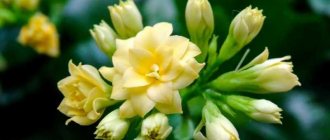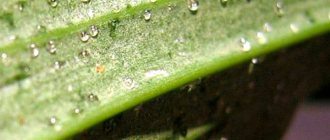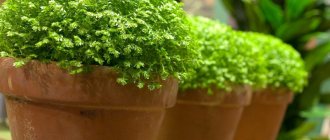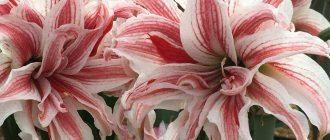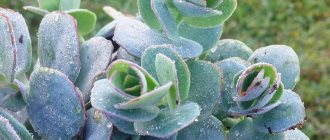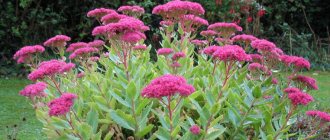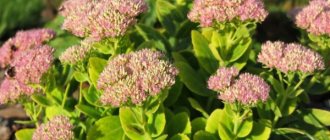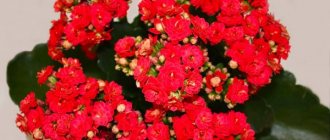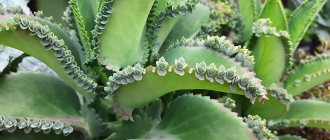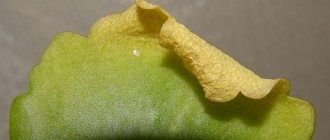Kalanchoe is a medicinal plant, unpretentious and easy to care for. It came to European latitudes from Africa and the Canary Islands. Tends to accumulate water, which contributes to survival in conditions of water deficiency. The stem can reach a height of more than one meter. Reproduces through leaves. It begins to bloom in winter with bright pink flowers. Kalanchoe does not like excess moisture, despite its tropical origin. It is watered so that the soil is moist, but not wet, and so that there is no water left in the pot.
Family doctor, or Kalanchoe doctor, as the flower is often called, is a very useful indoor plant. It does not require special care, and its benefits are more than enough.
What does it look like
Chemical composition
Kalanchoe is a plant rich in various beneficial substances. Its leaves contain complex carbohydrates, polysaccharides, which are the main sources of energy, and flavonoids, which are very similar in composition to human hormones. They contain a lot of organic acids (citric, malic, oxalic, acetic) that maintain the acid-base balance in the body.
The plant also contains vitamins C and P, tannins, cardiac glycosides and a large number of minerals, including calcium, magnesium, aluminum, iron, copper, silicon, manganese. Each of these substances is essential for the normal functioning of the body.
What does Kalanchoe look like?
People often argue among themselves about indoor plants. One points to a flower with a sharp leaf and says it is a Kalanchoe. The second one disagrees: they say that Kalanchoe has leaves with smoothly rounded edges. Most often, both debaters are right: botanists classify almost 200 species of plants in this genus, and they are very different from each other! Some are huge trees almost 4 m high, others are very tiny bushes no more than 20 cm high.
Both their leaves and stems differ from each other: in size, shape, and color, which can be lush green, or maybe almost blue.
Kinds
Among this variety of Kalanchoe species, only three are used for medicinal purposes - Kalanchoe Degremon, Kalanchoe pinnate and Kalanchoe Blossfeld.
- Kalanchoe Degremona - grandmothers called this flower a surgeon without a knife and always grew it on their windowsill, since they were well aware of its medicinal abilities. And to this day it is the one that is most often used for treatment at home than other types. This plant has leathery leaves, elongated, shiny, slightly bent in half lengthwise, with a pointed tip and small teeth along the entire perimeter of the leaf. On these cloves many tiny plants grow, which, despite their small size, have a completely finished appearance - right down to their own roots. When these plants fall, they take root well and begin to live their own lives. This non-flowering species of Kalanchoe is usually kept in the house precisely because of its medicinal qualities.
- Kalanchoe pinnate is also a happy frequent resident of indoor window sills. It is grown for decorative purposes and most often it is not even assumed that it is actually useful. And those who are aware of its healing abilities gave it the name homemade ginseng. This plant is a flowering plant, although it rarely produces flowers in an apartment. They are small - slightly less than 1 cm, have a pink-yellowish color and are collected in inflorescences located in the axils of the leaves. The leaves themselves are large, sometimes they grow up to 20 cm in length and up to 12 cm in width. The leaves are serrated along the edges, and buds arise in the cloves, which are used for plant propagation. This type of Kalanchoe is grown on an industrial scale to produce medicines for dentistry, surgery, and gynecology.
- Kalanchoe Blossfeld is the third species, widespread in homes and suitable for medicinal use. It blooms very decoratively with white, red or orange small flowers, collected in quite noticeable inflorescences. It usually blooms in winter and delights with bright flowers almost until May. The leaves of Kalanchoe Blossfeld are not very large - about 5 cm, but juicy, shiny and fleshy.
These three types practically coincide in their medicinal qualities and can be used to treat the same diseases.
Flower growers who are passionate fans of Kalanchoe grow several more species of this plant, but they no longer have practical applications and are not used to prepare medicinal products.
Collection and storage
Since Kalanchoe is grown at home all year round, there is no particular need to store kilograms of the plant for future use. At any time of the year, you can go to the windowsill and pick the desired leaf if there is an urgent need for it.
If you decide to prepare a healing composition for planned treatment, you must stop watering the plant a week before collecting the raw materials. After this period, the leaves need to be cut off (it is best to choose those that grow from below), washed, wiped with a towel and put in the refrigerator for another 5–7 days. Let them sit in a fruit drawer: this will trigger the biological mechanisms for the production and accumulation of beneficial properties. And only after this can you prepare decoctions, tinctures, infusions and other medicines, as well as squeeze the juice.
Botanical description of the plant
Kalanchoe Blossfeld unites a large group of different varieties. It can be found in natural conditions in Madagascar. The plant is classified as a succulent and is quite unpretentious.
Did you know? Translated from Portuguese, “kalanchoe” means “grass of life.”
The height of Kalanchoe of this species can grow on average up to 25 cm. There are also 1.5-meter specimens. Large round or egg-shaped leaves grow on bare stems. The leaves are wavy at the edges. Flowering is abundant and long lasting, lasting from the beginning of winter until the beginning of summer. The buds have a bright color. It is usually yellow, white or red, but the exact shade depends on the variety.
| Root system | small, sensitive |
| Stem | bare, weakly branched |
| Leaf Shape | round, ovoid, wavy at the edges |
| Leaf color | green, dark green |
| Flower shape | umbrella-shaped |
| Flower color | yellow, red, white (depending on variety) |
Medicinal properties of Kalanchoe
Thanks to a large number of vitamins, microelements and other natural substances, Kalanchoe has an extensive list of useful abilities that allow the plant to be used for medicinal purposes. In particular, it can destroy dangerous microorganisms, that is, it has bactericidal properties. Kalanchoe can stop the growth of bacteria, in other words, it has bacteriostatic properties.
In practice, its ability to inhibit the inflammatory process, stop bleeding, pull out dead tissue from wounds (this is where the name “surgeon without a knife” comes from) and heal damage is used. Medicine uses it in various fields. For example, otorhinolaryngologists treat sore throats, rhinitis, sinusitis, and sinusitis with the plant. Influenza, acute respiratory infections and acute respiratory viral infections are also in the area of application of the plant. In dentistry, the properties of the plant are used in the fight against stomatitis, gingivitis and periodontal disease. It also helps solve skin problems and treats eczema, acne, and psoriasis.
The plant is very widely used in the treatment of all kinds of wounds, ulcers, erosions, cracks, and varicose veins.
For women
Kalanchoe is also successfully used in the treatment of gynecological diseases. It can help heal cervical erosion and relieve inflammation of the cervical canal mucosa (or cervicitis). After childbirth, the juice of the medicinal plant promotes the speedy healing of tears and deep cracks in the perineum. To do this, it is recommended to apply a gauze cloth moistened with juice to the wound for several minutes, having previously lubricated the skin around the crack with furatsilin ointment or synthomycin emulsion. As a rule, 5 days are enough for such procedures.
Kalanchoe will also help heal cracked nipples, which often appear in women immediately after childbirth who are just starting to breastfeed. To do this, its juice should be dripped onto the nipples 4 to 5 times a day. It is most convenient to use a pipette. The cracks will disappear in about 6–7 days.
The flavonoids contained in the medicinal plant will help you more easily survive unpleasant symptoms during pre- and postmenopause. In their structure, they are similar to female sex hormones and have the ability to reduce the amount of lipids in the blood and weaken the rate of oxidative processes, which makes the process of withering of the body smoother and less painful.
For men
This natural medicine can be successfully used not only by women, but also by men. In particular, it helps improve well-being in cases of prostate adenoma and prostatitis, which is common in men who exercise little and are overweight. For these reasons, blood circulation in the pelvic organs is difficult, which becomes the cause of the disease. For treatment, either fresh Kalanchoe leaves or alcohol tincture are used. The whole leaf can be applied to the sore spot and compresses can be made from the tincture.
Also, due to the presence of flavonoids in the plant, it becomes a good prophylactic agent that prevents prostate cancer. The benefits of Kalanchoe have been confirmed by research. Certain compounds can prevent the development of prostate cancer. The beneficial properties of flavonoids for men were confirmed by a study that showed that the risk of this disease is reduced by 30% if you regularly chew a Kalanchoe leaf.
During pregnancy
Every pregnant woman, trying to protect her unborn baby from the negative effects of chemical medications, tries to find folk remedies for treatment when she has a cold. In this case, Kalanchoe will be a good helper: its juice can be used to treat a runny nose. To avoid getting a burn to the mucous membrane, it is better to dilute the juice in half with boiled water. The resulting drops should be instilled into the nose in the mornings and evenings. As a result, much less mucus is released, and the woman is able to breathe freely.
Those who have high blood pressure or are predisposed to it should use this remedy with extreme caution. Individual intolerance to the plant is also possible.
Video:
what herbs destroy the fetus during pregnancy Expand
For children
Treating runny noses in children with Kalanchoe is a long-standing tradition; in some families this method has been used for several generations. It is important to remember that babies under one year old do not need to use Kalanchoe. Those who are older can only instill a decoction of the plant, but not the juice. When the child has grown up and is already 10 years old, you can start making drops from the juice, and be sure to dilute it with boiled water in equal parts. Cotton swabs soaked in these drops also help a lot if you put them in each nostril for 5-6 minutes in the mornings and evenings. You cannot add the juice of other plants to the drops for children - for example, aloe or onion.
Before dripping the healing liquid into the child’s nose, you need to conduct a sensitivity test - drop one drop on the inner surface of the elbow and observe if redness appears. This rule applies to children of all ages and all dosage forms - both juice and decoction.
Doctors do not recommend formulations based on this plant if the child has a fever.
Parents need to understand that Kalanchoe drops only help with inflamed adenoids, colds, acute respiratory infections or acute respiratory viral infections. They cannot get rid of a runny nose of an allergic or physiological nature; in such cases, you need to look for other remedies.
When losing weight
No obvious effect for weight loss has been noticed with Kalanchoe, but if you use it as a strengthening and digestive remedy, it is quite suitable for inclusion in a comprehensive weight loss program.
Contraindications to the use of Kalanchoe
People with diseases of the liver, kidneys and joints should be more careful when treating Kalanchoe. There may be allergic reactions in nursing and pregnant women (during pregnancy it is generally advisable to refrain from treatment with this method).
Before use, it is better to consult a doctor, especially for people prone to allergies. Also, you should not use the plant juice for low blood pressure, tumors, or hepatitis.
Note! In its pure form, Kalanchoe is not suitable for children, because the child may have a burn to the nasal mucosa. It is best to test for allergic reactions before use to avoid unwanted effects.
All medications, even if they are natural, should be used after consultation with a doctor; this is a prerequisite for treatment.
Kalanchoe in folk medicine
For diabetes
If a patient with diabetes consults a doctor about the benefits of Kalanchoe for diabetes, the doctor will definitely explain that with this disease the body needs a constant supply of calcium, which is found in sufficient quantities in the juice squeezed from the leaves of the plant. If the patient tolerates Kalanchoe normally, you can safely take a tablespoon of it per day. The main thing is not to overdo it and not to try to increase the dose. This will not have a positive effect on the course of diabetes, but you can harm yourself.
You can add insulin to the juice and take this composition for a month. But first you need to consult a doctor.
In addition, those who suffer from diabetes often have problems with their feet. Even the smallest injury, scratch or blister can provoke a large infectious process and result in a trophic ulcer. Such ulcers are also treated with kalachoe juice mixed with novocaine, lanolin and furazolidone.
You need to lubricate sore spots up to 4 times a day. At first, after the procedure, the ulcer will burn and sting quite noticeably, but after 7 minutes the painful sensations will pass.
You can apply lotions to the ulcers using Kalanchoe juice with the addition of aloe juice. You need to mix the juices equally, soak the bandage with them and apply to the wound.
For gastritis
Gastritis is treated by taking Kalanchoe juice orally. It has a beneficial effect on the gastric mucosa, reducing and then relieving the inflammatory process, promoting tissue repair and reducing pain. To ease gastritis, you can drink a teaspoon of juice 3 times a day.
If you mix the juice in half with an infusion of juniper berries and centaury and wacht leaves, and then drink this remedy a tablespoon at a time, the secretory activity of the stomach will increase and the process of digesting food will be easier. Therefore, you need to take the healing composition before meals.
For the intestines
To treat intestinal problems, you need to prepare an alcohol tincture: pour about a third of the volume into a completely dry dark glass jar and fill the container to the top with alcohol. Infuse for a week, sealed, and after straining, store in the same dark glass container. Use not only for treatment, but also for the prevention of gastroduodenitis, colitis and enterocolitis: the daily intake rate is a teaspoon 15–20 minutes before each full meal (snacks do not count).
To alleviate the condition of acute colitis, you need to mix the tincture with a decoction of yarrow herb. This product acts more gently and does not taste as harsh. Pour a tablespoon of herb into a small glass of water, simmer over low heat for 10 minutes and, when it cools, strain the broth. Dilute the tincture with the decoction in half, take a tablespoon 5 to 7 times a day. The pain will decrease, stool will return to normal, appetite and the condition of the body as a whole will improve.
Exacerbations of chronic colitis can be prevented by taking this remedy: take equal parts of Kalanchoe and plantain leaves, grind them through a meat grinder and pour in a very small amount of water so that it just covers the mixture of leaves. After 20 minutes, squeeze out the liquid and drink the healing composition one tablespoon 3 times a day. After a course lasting 15–20 days, you need to take a break for a month.
For the liver
All problems in the functioning of the liver and the accompanying gallbladder, as a rule, are due to inflammatory processes, as a result of which the formation of bile is disrupted and various congestion appears.
A collection containing Kalanchoe will help with these problems. You need to take calendula, dill seeds, Kalanchoe babies, juniper fruits (2 tablespoons each). Add chamomile, strawberries, rose hips, horsetail, corn silk (4 tablespoons each). Pour 3 tablespoons of the collection with half a liter of boiling water, leave for an hour and a half, strain and take a whole glass 15 minutes before meals 3 times a day.
Another collection: take a spoonful of St. John's wort and the same number of Kalanchoe babies per glass of boiling water. Pour in and leave for 2 hours. Add a tablespoon to tea. Take a course of 5 to 7 days.
Important:
Before using liver preparations, you need to do an ultrasound!
For hemorrhoids
The use of formulations with Kalanchoe for the treatment of hemorrhoids is based on its ability to reduce inflammation, normalize blood circulation and relieve pain. To do this, you can make compresses, lotions or baths.
Soak a gauze pad with the juice of the plant and carefully apply it to the inflamed and enlarged hemorrhoid. Keep the healing composition on the sore spot for 15 to 20 minutes.
Baths are good for hemorrhoids. For them, half a glass of juice should be mixed with an infusion from the following set of medicinal herbs: horsetail (30 g), oak bark (50 g), valerian root (20 g). To obtain an infusion, one tablespoon of the mixture is enough. Pour half a glass of boiling water over it. After an hour of infusion, the healing composition is ready. Pour the infusion mixed with Kalanchoe juice into a bowl of warm water (it should not be hot!) and sit in it for 15 minutes.
An ointment made from Kalanchoe juice and Vaseline, taken in a 1:3 ratio, has a good effect on hemorrhoids.
For prostatitis
An alcohol tincture is used to treat inflammation of the prostate. You need to take 100 g of leaves and fill them with 200 ml of alcohol. Filter the medicine after infusing for 10 days in a dark place. Take the medicine orally - a teaspoon before breakfast, and also an hour before bedtime. As soon as the condition improves, it is better to reduce the dosage.
You can use another scheme for using the tincture - drink it once a day, on an empty stomach, but increase the volume of the product to 1.5 teaspoons. In this case, continue taking it until the symptoms disappear completely.
Each patient chooses a treatment method that is suitable for himself - but only after consultation with a doctor.
For preventive purposes, it is recommended to chew a piece of fresh Kalanchoe leaf every day.
Against cough
If you suffer from paroxysmal lingering cough, a mixture of Kalanchoe juice with melted butter in a 1:1 ratio will help. Before breakfast, lunch or dinner, you should drink a tablespoon of this remedy.
Another old-fashioned, but true way: cut off the bottom of a black radish, make a depression in it and put very finely chopped Kalanchoe leaves and a spoon of honey into it. Cover the hole with the cut bottom and put the radish in the refrigerator. When the juice comes out, drain it and drink a tablespoon before eating. Radish can be reused, but it is better to chop Kalanchoe again.
For a runny nose
An excellent remedy for the common cold is obtained from a mixture of Kalanchoe and aloe. You need to mix the juice of these two plants in equal parts. You can prepare the daily amount immediately and put it in the refrigerator. Place 3 drops into each nostril.
Kalanchoe has proven itself to be excellent for treating a runny nose and in a duet with onions - the juice of both plants should also be mixed in half. However, this rather aggressive mixture is not suitable for everyone - it may well burn the mucous membrane. Therefore, before dripping into the nose, you need to apply the composition to the inner bend of the elbow. If no redness appears, you can safely use it to combat a runny nose.
Another option for homemade drops for the common cold is Kalanchoe juice with a decoction of St. John's wort or lemon balm. Mix the liquids in equal parts. This composition not only makes it possible to breathe normally, but also has antimicrobial and anti-inflammatory effects.
These products are suitable only for adults; in children under 10 years of age they can burn the mucous membranes. It is better for children to treat a runny nose with a decoction of Kalanchoe.
For sinusitis
If a cold or acute respiratory viral infection has gone too far and the patient is diagnosed with sinusitis, it is necessary to treat it with a tincture of Kalanchoe with aloe: instill 2 drops 3 times a day. At the same time, you need to throw your head back.
To make the treatment go faster, you can additionally once a day, preferably before bed, place cotton swabs with ointment on them for 5-6 minutes in the nostrils. It is also easy to prepare at home: you need to mix a tablespoon of Kalanchoe juice with 50 g of petroleum jelly and the same amount of lanolin.
If the inflammation has spread to several sinuses and sinusitis has developed, a stronger and more effective ointment is needed. To prepare it for the previous recipe, you need to add a teaspoon of aloe, onion and cyclamen root juices, mix and add Vishnevsky ointment (10 g) to the resulting mixture. Treatment with this composition should be carried out 3 times a day. The general course lasts 25–30 days.
Video:
beneficial properties of Kalanchoe Expand
For joints
You need to remember: compositions with Kalanchoe for the treatment of joint problems are used only externally! In this case, they will not cause complications, will be useful, improve motor activity, and remove inflammation and pain.
To prepare the composition for rubbing, 4 tablespoons of crushed leaves need to be poured with half a liter of alcohol in a glass or enamel container. Leave the mixture under a tightly closed lid for about two weeks. Store the finished product in the refrigerator and rub it on sore joints once a day.
You can get rid of pain with the help of a compress, for which you mix an alcohol tincture with chalk and one or two spoons of kefir. You need to ensure that the consistency of the mixture is similar to sour cream.
At night, before going to bed, you need to smear the sore joint with the prepared product, cover it with plastic wrap and wrap it with a bandage or suitable cloth. Sleep with this compress all night.
You can make another composition for grinding: mix honey, Kalanchoe juice and grated black radish in equal proportions. Before using this product, you need to let it sit for a couple of hours.
A good effect is obtained from grinding with a mixture of juice and grated (or minced) horseradish.
For varicose veins
Alcohol tincture of Kalanchoe has a good effect on the veins, which stimulates blood circulation in the legs. Therefore, for those who suffer from varicose veins, you can rub Kalanchoe tincture into your legs from bottom to top - from the feet to the hips. It improves blood microcirculation, which will significantly reduce the number of spider veins. Relief of heaviness in the legs, reduction of pain, and relief from cramps will not take long. To obtain a sustainable healing effect for a long time, you need to carry out procedures with the tincture for at least four months.
The tincture must be prepared from 2 tablespoons of crushed Kalanchoe leaves and half a liter of vodka. Infuse the composition for 10–12 days, shaking approximately once a day.
For a cold
To get rid of germs and viruses, it is very good to chew Kalanchoe leaves. This, by the way, will help soften your throat and ease your cough.
A cough can be treated by taking juice diluted in half with boiled water. Taking half a tablespoon twice a day is enough. The same composition can also be used as nasal drops. If you have a cold, you need to take drops 3 to 4 times a day. If you add a little aloe juice to the drops, then this composition will act faster and softer.
For warts
Warts and papillomas can be cured with the leaves and juice of Kalanchoe. It is better to use the medicinal plant after it has been in the refrigerator for two weeks. There are several ways to get rid of these skin problems.
- Firstly, you can simply rub Kalanchoe juice into the wart in the mornings and evenings. Already on the second day it will be noticeable how the growth began to respond to treatment by changing color.
- Secondly, you can take an alcohol tincture from Kalanchoe as a life-saving remedy. To prepare it, mix 100 ml of vodka with 3 tablespoons of finely chopped leaves of the plant. After a week of infusion in a dark, warm room, the remedy is ready. Rub it into the wart in the mornings and evenings until it disappears.
- Thirdly, an ointment made from Kalanchoe juice can defeat warts. It needs to be mixed with olive oil, and take 2 times more juice. Keep the resulting composition for half an hour with constant stirring in a water bath. When it cools down, you can rub it into the growths on the skin.
In order for Kalanchoe to act more effectively, before any of these procedures you need to smear the wart with a decoction of wormwood, celandine or calendula.
For sore throat
Kalanchoe drops with aloe, prepared for instillation into the nose for a runny nose, can also be used to treat sore throat and tonsillitis. To rinse, the drops need to be diluted in equal parts with boiled water - and the solution is ready. To treat not only the throat, but also the nasopharynx, you can instill this diluted solution into your nose 4-5 times a day - 2 drops in each nostril. This composition can also be used to treat children.
For burns
In case of frostbite, you can simply drip Kalanchoe juice onto the damaged sore spot. Repeat the procedure 3 to 4 times a day.
You can not squeeze the juice, but use a whole leaf of the plant, applying it to the wound and securing it with a bandage. After 4 hours, change the sheet and take a fresh one.
If the wound is large enough that one sheet is not enough, you can soak a gauze pad in the juice and apply it. This bandage should be removed after 5 hours.
For herpes
Itching and burning during herpetic rashes can be relieved with the help of Kalanchoe juice due to its immunostimulating and antiseptic effects. You can enhance the effect of the juice by adding a little honey. This composition is suitable not only for lubricating rashes, but also for oral administration.
Instead of squeezing the juice, you can use crushed leaves. To do this, you need to take an equal mixture of leaves and honey, mix the ingredients and let it brew for 10 hours. Eat a tablespoon of this delicious medicine 3 to 4 times a day.
For toothache
The effect of Kalanchoe juice is very similar to novocaine, so it can be used to neutralize toothache. Crushed leaves should be applied to the cheek, covered with plastic wrap and tied with a warm scarf to speed up the pain relief process.
Alcohol tincture also relieves pain for various problems in the oral cavity - stomatitis, gingivitis and periodontitis. You can rinse with alcohol tincture alone or dilute it with calamus setting. Instead of rinsing, you can make applications: soak gauze napkins with the juice of the plant and apply to the gums.
For stomatitis, tampons soaked in Kalanchoe juice have a good effect. You need to repeat this procedure up to 4 times a day, holding the tampons for 10–12 minutes. Relief will come quite quickly.
Treatment of runny nose and sinusitis
Be sure to look at what Kalanchoe for the common cold looks like in the photo. The Cirrus species is best suited for these purposes. During an illness, it is useful to drip the juice of the plant into the nose, and you can get it in the following way:
- Wash the leaves and chop them finely.
- Place the plate with the leaves in the refrigerator for several days, only then can they be put through a meat grinder and the juice extracted.
- The medicine needs to be renewed every two days.
For a slight runny nose, it is enough to wipe the nostrils with a cotton swab dipped in healing liquid. Children under two years old need to reduce the concentration of juice by diluting it with boiled water.
Dosage for sinusitis and common runny nose: three times a day, a couple of drops in each nostril.
In case of complications, it is permissible to consume the plant juice orally, but such treatment must be prescribed by a doctor. One large leaf or several small leaves yield up to 100 grams of juice. This amount is most often the daily dose. But before you start therapy, be sure to ask your doctor for a photo of Kalanchoe medicinal, so as not to be mistaken with the type of ingredient. You should not abuse the drink, as its excessive accumulation in the body can be toxic. The optimal dosage is no more than five grams per kilogram of human weight.
Types of healing compositions with Kalanchoe
Infusion
To prepare the infusion, crushed Kalanchoe leaves need to be poured with boiling water in an enamel pan. For external use, the proportions should be 1:5, for internal use - 1:10. Then simmer the composition in a water bath for 15 to 20 minutes under a closed lid.
The infusion can be used as a lotion to treat burns, festering wounds, varicose veins, and skin problems. They are used to gargle the throat and mouth during inflammation.
This composition is recommended to be taken internally to treat diseases of the digestive system and get rid of gynecological problems. It has also proven itself in cases of gastritis with low acidity and chronic colitis. For colitis, it is recommended to take the infusion half an hour before meals, twice a day for a month.
Tincture
The alcohol tincture has a fairly long shelf life - a year. Therefore, you can prepare more of this medicine at once. You need to take the leaves that have been lying in the refrigerator, chop them and fill a half-liter bottle with them, pour alcohol or vodka into it. Seal the bottle tightly and place it in a dark place for a week. During this time, you need to shake it 6-7 times. Then strain the mixture, pour it into another glass container and put it in the refrigerator until needed. It can be used to treat varicose veins and pustular inflammation.
Decoction
This decoction, popularly called sneezer, can be used to treat runny noses in children under three years of age. To prepare it, add 4-5 leaves of the plant to 100 ml of water and bring to a boil over low heat. Remove and leave for another hour, then strain and pour into a glass container. Place one drop in each nostril. Usually after instillation the baby sneezes. This is a normal reaction to the medicine. A runny nose after this treatment goes away in two to three days.
Ointment
Kalanchoe ointment is quite popular. It is used to smear bedsores, treat wounds and fistulas. If you apply a napkin with lubricant to an abscess, a frostbitten area, or anoint a rash on the skin, it will quickly cope with acute pain. Cosmetologists use the ointment to get rid of acne and lighten dark spots. This remedy is also good for patients with varicose veins. Even a runny nose can be treated with ointment: in such cases, each nostril should be treated from the inside with medicine applied to a cotton swab. During an epidemic of influenza and ARVI, this method will protect you from the virus.
To prepare the ointment, you need to take a tablespoon of Kalanchoe juice and add to it 100 g of lanolin and 0.25 g of novocaine and furazolidone. Mix everything well so that the mixture eventually has the consistency of thick cream. The prepared ointment is stored at room temperature.
Oil
You need to pour freshly squeezed Kalanchoe juice into olive oil in a 1:1 ratio. Mix the composition and leave in a dark room for three days. The oil is ready. It can be used for cosmetic purposes (for example, using it to prepare masks, adding decoctions of other medicinal plants - chamomile, calendula, string) or in the complex treatment of stomach ulcers. Then you need to add a little honey to the oil, boiled in a water bath for half an hour.
Juice
To get enough juice and at the same time good quality, with a large amount of useful substances, you need to prepare the leaves of a plant that is at least two years old. When planning to harvest juice, you need to stop watering 7 days in advance. It is better to cut off the most fleshy and large leaves - they will yield more healing juice.
Wash the leaves, dry them with a towel and put them in the refrigerator; after they have sat for a week and accumulated useful substances, chop them. You can crush the Kalanchoe using a blender, meat grinder or garlic press, and then squeeze out the juice using gauze. Pour the squeezed juice into a glass container with a well-fitted stopper and put it in the refrigerator. The finished product should not be stored for longer than two to three weeks.
We recommend reading:
types of healing compositions with plantain
Read
What does Kalanchoe treat?
Phalaenopsis orchid: main types and home care options
What Kalanchoe cures is a common question on the Internet. Here is a short list of diseases for which this representative of the flora helps:
- rhinitis;
- colds;
- inflammation of the mucous membrane of the nose and sinuses;
- healing of wounds and burns, the juice has restorative properties;
- bleeding;
- diseases of the digestive system.
Ointment
Application in cosmetology
Homemade cosmetics from Kalanchoe are very effective and quite popular. Women have learned to use its beneficial properties to be beautiful, for which they prepare masks or lotions. It should be remembered: if the cosmetic product causes irritation or any other negative reaction occurs, the procedures must be stopped.
For beautiful facial skin
Kalanchoe can normalize the skin, cleanse pores, remove excess fat, get rid of rashes, and lighten age spots.
To cleanse the skin and acquire a beautiful color, you need to remove the skin from the leaf and wipe your face with the pulp. Then lightly slap the skin and wait until the healing composition is absorbed. Without washing your face, immediately apply moisturizer to your face.
If you need to dry out overly oily skin a little, add linden, chamomile and mint leaves to a small amount of boiling water and drain the water after half an hour. Mix Kalanchoe juice with steamed herbs and apply to facial skin for 20–25 minutes.
Lotion for youthful skin
This product can be used not only on oily but also on dry skin. Mix a tablespoon of juice and half a glass of boiled water with a teaspoon of honey. You can use this product after washing your face in the evening as a skin care product.
For beautiful hair
Useful products based on Kalanchoe - masks and decoctions - make hair stronger, thicker and softer, and give it a beautiful shine.
For the mask, you need to mix a teaspoon of Kalanchoe, garlic and birch juices, as well as honey. Add egg yolk, stir. Apply to hair, distribute the mask over its entire length, wrap cling film around your head and place a large towel on top of it. After 2 hours, wash off the mask with shampoo.
For hands and nails
Kalanchoe does an excellent job of softening hands. In addition, thanks to the antiseptic properties, its juice treats nail fungus, as a result, both the nail plate and the cuticle quickly return to a normal, healthy state.
You can mix a drop or two of Kalanchoe juice with your regular hand cream, which is used daily. It is better to lubricate your hands before going to bed, and then put on special cotton gloves.
To get rid of fungus, wrap each nail with gauze soaked in juice. Then put on cotton gloves. Repeat the procedure every day, or at least every other day, until the fungus disappears.
How to properly care for Kalanchoe
Kalanchoe is quite unpretentious, but does not like very hot sun; the best place for it is an eastern window, where there is sun only until lunchtime. The room needs to be ventilated often, but the plant does not like drafts.
The temperature must be kept at +20...+25°C in summer, and +15°C in winter, otherwise the Kalanchoe may die. In summer it would be good to take the plant out onto the balcony or veranda.
You should not water Kalanchoe too much; it does not tolerate waterlogging, as the roots may begin to rot. The soil should have time to dry out between waterings. In summer, you need to water once every 3-4 days; in winter, the break should be from 8 to 15 days. The water should sit for a day before watering.
The plant grows quickly, it often requires transshipment, but it is better to do this in the spring. The pot should be 3–4 cm wider than the previous one, making sure to add drainage to the bottom so that the roots do not rot. The soil is best made from a mixture of leaf and turf soil.
Kalanchoe propagates by cuttings, seeds and children.
Video:
how to care for Kalanchoe Expand
Growing conditions
Kalanchoe Blossfeld is a very unpretentious succulent. Nevertheless, its vital activity must be maintained by establishing the proper microclimate.
Placement and lighting
Immediately after purchase, the succulent is placed in a shaded place and gradually accustomed to exposure to bright light. After adaptation, the flowerpot should be placed in a well-lit place. You can choose a window sill as a permanent place, preferably located near an east or west window. It is also necessary to ensure that the green part is not exposed to direct rays of the sun. If necessary, the plant is slightly shaded.
When daylight hours become less than 12 hours, special lamps can be used. Artificial lighting will help the plant not to stop developing.
Important! If the light is too intense, burns may appear on the leaves.
Temperature
Kalanchoe Bossfeld is a heat-loving plant, but do not raise the temperature too much. In summer, the optimal temperature should be +24...+28°C, while it is better to set a constant heat level of +25°C.
In the winter season, the room temperature is reduced. Comfortable thermometer readings during this period for a succulent are +16…+18°C.
Air humidity
Since Kalanchoe Bossfeld is a succulent, it prefers dry air. The flowerpot does not need additional moisture in the form of spraying from a spray bottle or a light shower. They can only be used to clean the leaves of excess accumulated dirt.
Can Kalanchoe leaves be eaten fresh?
At first, people noticed the medicinal abilities of Kalanchoe and only then decided to try to use it for culinary purposes. The plant is rich in vitamins and minerals, so dishes made from it are really healthy, but since its leaves have a sharp, bitter taste, they are not widely used. Such dishes are more suitable for those who are interested in therapeutic nutrition, since they help restore the body after surgery or a debilitating illness, help cleanse the blood, protect against colds, and remove harmful substances.
Cucumber best reduces the astringency and bitterness of Kalanchoe, so in combination with it the medicinal plant is quite possible in a salad.
A good combination of Kalanchoe with carrots or avocado, green salad, fresh peas in olive oil dressing with lemon juice.
You can try making a vinaigrette with Kalanchoe. For it, as usual for such a dish, you will need to boil 3 potatoes, one beet and one carrot. Peel and chop the vegetables, add 2 chopped pickles and a handful of sauerkraut. Also chop pickled champignons (40 g), Kalanchoe leaves (30–40 g), and green onions. Salt, pour in sunflower oil - preferably unrefined, with the smell of seeds.
Folk signs and superstitions
The healing properties of Kalanchoe are reflected in various folk superstitions. Esotericists believe that the plant has good energy and brings prosperity, goodwill and mutual understanding to the home. If you place a flower in the living room or kitchen, household members will have less conflict with each other. But the bedroom is not a very good place for a succulent, since it has the ability to invigorate people and fill them with vital energy rather than calm them down. But by approaching the flower in the morning and standing next to it for a while, you can wake up as quickly as after a cup of aromatic coffee.
Did you know? They say that a dead Kalanchoe is a direct sign that someone in the household was damaged, and the flower “took the blow.” In this case, you need to purchase a new plant as quickly as possible.
However, if the plant does not bloom, this means that its strength is not enough to overcome lies, pretense and other negativity that reigns in the house.
Lovers of all things mysterious will be interested to know that Kalanchoe is credited with the following abilities:
- help household members in all their household affairs;
- protect home comfort and health of everyone who lives in the house;
- fight “energy vampires”, returning the vitality they stole;
- recover quickly after a hard day - both emotionally and physically;
- absorb and neutralize negative energy and even make evil people kinder.
Kalanchoe has many healing properties, but it must be handled with extreme caution. The biologically active substances that make up this succulent are very active and even aggressive. They can relieve adults from various painful conditions, but before using the plant to treat children, you should obtain detailed and qualified advice from your family doctor or pediatrician.
Is Kalanchoe poisonous to cats?
Cats quite often try to chew on indoor plants, and not all inhabitants of a home windowsill are useful or at least harmless to them. For example, although Kalanchoe is considered a medicinal plant, it is dangerous for a cat, as it can seriously damage the pet’s health and even cause poisoning. It causes irritation of the gastrointestinal tract, resulting in vomiting and diarrhea. The juice of the plant can in some cases even provoke heart problems, including heart rhythm disturbances.
Video:
what flowers are dangerous for cats, dogs and other pets Expand
Benefits of Kalanchoe - 7 facts
Let's consider the main medicinal properties of Kalanchoe for our body (based on scientific sources of information).
Eliminates kidney stones
Indian experts claim that the aqueous extract of Kalanchoe has an anti-urolitic effect.
The plant prevents the formation of the most common type of stones (oxalates) in the lumen of the urinary system.
Thanks to its anti-inflammatory properties, Kalanchoe also reduces inflammatory changes caused by obstruction of the urinary ducts by stones.
In addition, the plant can alleviate urethritis, cystitis and pyelonephritis.
Kalanchoe can be used to prevent and alleviate urolithiasis.
Supports stomach health
According to Brazilian scientists, Kalanchoe has gastroprotective activity.
It reduces the acidity of gastric juice and also restores the bicarbonate layer near the mucous membrane, which prevents the irritating effects of hydrochloric acid.
The plant can be used for any chronic diseases of the gastrointestinal tract during exacerbation (GERD, gastritis, duodenitis, gastric and duodenal ulcers).
Kalanchoe is an excellent addition to the usual medications used for ulcers of the mucous membrane.
The healing plant protects the mucous membranes of the digestive system. It is effective during periods of exacerbation of chronic diseases.
Has anti-inflammatory and antioxidant properties
Kalanchoe is a valuable source of natural antioxidants for the human body.
The composition contains ferulic, caffeic, protocatechinic acids. These substances neutralize free radicals formed during oxidative stress. “Aggressive molecules” can cause cell damage, initiate the growth of malignant tumors and the emergence of chronic diseases.
When taking Kalanchoe, the concentration of key markers of inflammation in the blood - interleukins 1, 4 and 8, as well as tumor necrosis factor-alpha - decreases.
Taking the herb can reduce the likelihood of developing any chronic diseases (including obesity, diabetes, hypertension and gout).
Kalanchoe, thanks to antioxidants and anti-inflammatory substances in its composition, can protect against many chronic diseases.
Has a calming effect and improves sleep
Experts from the University of Basel (Switzerland) studied the effect of Kalanchoe on diseases with hyperactivity.
It was found that the plant improves the functioning of the central nervous system, relieves stress, anxiety, depression and various depressive disorders.
It also normalizes sleep (the time for going to bed is reduced, the depth of sleep increases).
Kalanchoe has been noted to be effective in cases of increased uterine tone and premature birth, and an overactive bladder (frequent urge to urinate in the absence of organic disorders). The pharmacological basis of the action of Kalanchoe in these disorders has not yet been studied.
The medicinal plant allows you to achieve psycho-emotional well-being during stress and depression, and improve sleep.
Supports prostate health in men
More than half of men over 50 years old are faced with such a problem as benign prostatic hyperplasia. The disease interferes with the quality of life (difficulty with urination and sex life).
Studies demonstrate the ability of Kalanchoe to reduce the size of the prostate and improve the excretion of urine from the body.
It has also been proven that the herb can reduce the likelihood of developing prostate cancer against the background of long-term prostatitis or prostate adenoma.
Kalanchoe alleviates symptoms of prostate adenoma and reduces the risk of developing malignant tumors of this organ.
Fights cancer
The antitumor activity of Kalanchoe has been proven. The plant is able to detect cancer cells and trigger the processes of apoptosis - programmed death - in them.
The herb not only limits the growth of cancer, but also prevents the appearance of distant foci of metastatic growth.
The effectiveness of Kalanchoe against tumors of the following organs has been confirmed:
- prostate;
- blood systems;
- lungs.
Some experts believe that Kalanchoe extract will in the future serve as the basis for the creation of antitumor drugs for certain forms of cancer in oncology.
Kalanchoe blocks the growth of tumor cells in the body, presumably reducing the risk of cancer.
Improves heart and vascular health
It has been proven that Kalanchoe extract causes vasodilation, which is accompanied by a decrease in high blood pressure.
The herb allows you to reduce the doses of medications taken for hypertension and prevent hypertensive crises.
Kalanchoe has a positive effect on lipid metabolism. It reduces the level of total and “atherogenic” (LDL) cholesterol in the blood and inhibits chronic inflammation in the walls of blood vessels.
As a result, the prerequisites are not created for the appearance of cholesterol plaques in the arteries and the development of such deadly diseases as coronary heart disease and myocardial infarction, chronic cerebral ischemia and stroke.
The plant is recommended for men and women of older age groups to reduce blood pressure, normalize cholesterol levels and prevent the development of cardiovascular disorders.
Kalanchoe lowers blood pressure and prevents the deposition of cholesterol in the walls of arteries, protecting a person from extremely dangerous diseases.

